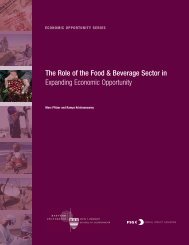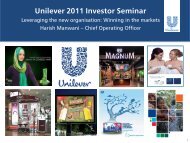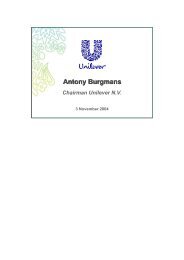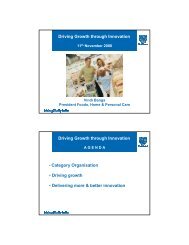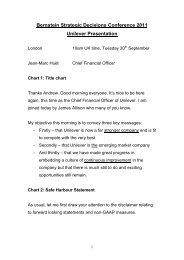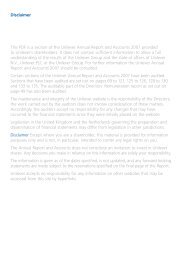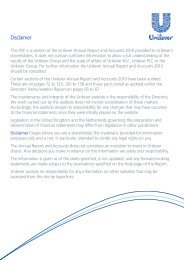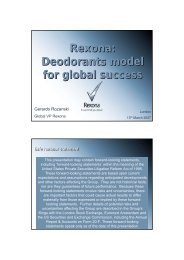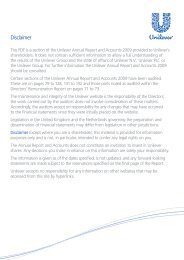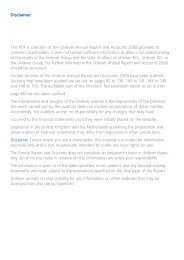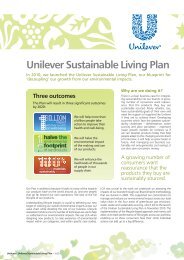Paper & board policy FAQx - Unilever
Paper & board policy FAQx - Unilever
Paper & board policy FAQx - Unilever
You also want an ePaper? Increase the reach of your titles
YUMPU automatically turns print PDFs into web optimized ePapers that Google loves.
o NEPCon Global Risk Registry: http://globalforestrisk.nepcon.net/<br />
o WWF GFTN: http://gftn.panda.org/<br />
o Greenpeace: http://www.greenpeace.org.uk/tags/illegal-timber<br />
o EIA/Lacey Act: http://www.eia-global.org/forests_for_the_world/lacey.html<br />
o ILLEGAL-LOGGING: http://www.illegal-logging.info/<br />
• Non-controversial sources: What is a „Supplier’s own Risk Assessment of the country or<br />
district of origin (forest)”? A document? Could you please provide an example?<br />
During our annual audits, we will expect from the selected suppliers to have a full report in place for<br />
the district of origin of the fibre (country, region or forest management unit), proving that the source is<br />
“low risk” for each of the controversial categories (civil and traditional rights violations, threatened high<br />
conservation values or forest conversion), by confirming the following:<br />
o There is no UN Security Council ban on timber exports from the country<br />
concerned (www.globalwitness.org and www.un.org ).<br />
o The country or district is not designated a source of conflict timber (e.g.<br />
USAID Type 1 conflict timber); (www.usaid.gov ).<br />
o ILO (International Labour Organization) country office confirms that there is<br />
no evidence of child labour or violation of ILO Fundamental Principles and<br />
Rights at work taking place in forest areas in the district concerned and,<br />
when applicable, that there is no evidence of violation of the ILO<br />
Convention 169 on Indigenous and Tribal Peoples taking place in the forest<br />
areas in the district concerned (www.ilo.org ; local NGOs).<br />
o District of origin of source material is not included in the WWF Global 200<br />
(http://www.worldwildlife.org/science/ecoregions/item1847.html ) and is not<br />
considered a “Biodiversity Hotspot” (http://www.biodiversityhotspots.org )<br />
o A strong system of protection (effective protected areas and legislation) is<br />
in place that ensures survival of the HCVs in the ecoregion. (I.e. Country<br />
has signed to the Convention on Biological Diversity<br />
https://www.cbd.int/information/parties.shtml ; Reliable Local and Global<br />
Environmental NGOs, etc.)<br />
o There is no net loss AND no significant rate of loss (> 0.5% per year) of<br />
natural forests and other naturally wooded ecosystems such as savannahs<br />
taking place in the eco-region in question.<br />
(http://www.fao.org/forestry/41256/en/ ; Google Earth, Local ENGO)<br />
Please note that compliance with legality shall be demonstrated in all cases and that this option<br />
(a supplier’s own risk assessment report) will not be enough for countries included in the<br />
Country Exception List, where third party certification will be required.<br />
• Non-controversial sources: What do you mean by „regarded as equivalent by 3rd party audit<br />
initiated by <strong>Unilever</strong>”? Who are the approved 3 rd parties? What standards will they follow?<br />
When FSC Controlled Wood certification is not available for some acceptable reason and the forest is<br />
not engaged in a stepwise approach towards FSC certification, we may accept other third party<br />
verifications, which will be studied on a case by case basis. In these cases we will ask an independent<br />
auditor entitled for forest management certification (FSC or PEFC approved certification body) to audit<br />
compliance with the following categories:<br />
o Wood is not harvested in violation of traditional and civil rights;<br />
4




